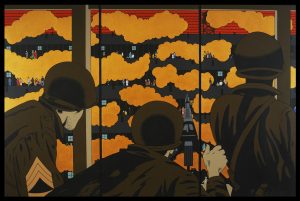Art exhibit immerses you in Japanese American history
Art reflects effect of Japanese American internment
March 11 - May 22, 2022, you will have an immersive opportunity to learn about the internment of Japanese Americans during World War II and its effect on following generations. The Alice C. Sabatini Gallery is the first location for this new traveling exhibit Resilience—A Sansei Sense of Legacy from ExhibitsUSA. This is an excellent, free opportunity to discover and experience the impact this historical event had and continues to have on many Americans.

Jerry Takigawa, Citizen’s Indefinite Leave, 2017; pigment print on Hahnemuhle Photo Rag, 22 x
17 inches; Courtesy of the artist.
In the years following Executive Order 9066’s retraction at the end of WWII, expatriate Japanese families and individuals were forced to come to terms with lost property, the shame and indignation of incarceration, and the task of re-integration into a society that had expelled them. After their release from the incarceration camps that dotted the American West and Midwest during the war, Japanese Americans used the phrase Shikata ga nai (it cannot be helped) and the word gaman (to persevere and stay silent) to speak to their resilience against the losses they incurred.
Artists use a variety of techniques
Told from the point of view of Sansei (third generation) Japanese Americans, Resilience—A Sansei Sense of Legacy is an exhibition of eight artists whose work reflects on the effect of EO9066 as it resonated from generation to generation. Several artists in Resilience employ traditional Japanese methods in the construction of their work. Lydia Nakashima Degarrod uses boro stitching on her works on paper. Judy Shintani created kimono cutouts honored in ceramic vessels. Others use iconography relating to Japanese culture as a jumping-off point for personal explorations on the subject of the incarceration camps. Reiko Fuji created photographs-as-kimono. Wendy Maruyama constructed columns of replicated camp ID tags. In their own way each artist expresses moments of deeply felt pain and reluctant acceptance, emotions that were often withheld by their elders.

Roger Shimomura, American Infamy #6, 2015; acrylic paint on canvas, 72 x 108 x 2 inches; Courtesy of the artist.
Exhibition artists are: Kristine Aono, Reiko Fujii, Wendy Maruyama, Lydia Nakashima Degarrod, Tom Nakashima, Roger Shimomura, Judy Shintani and Jerry Takigawa.
This exhibit was co-curated by Jerry Takigawa and Gail Enns. Resilience—A Sansei Sense of Legacy is a Program of ExhibitsUSA, a national division of Mid-America Arts Alliance with The Kansas Creative Arts Industries Commission and The National Endowment for the Arts.
Camp Minidoka: Building a prison camp in the high desert

Camp Minidoka, Japanese Internment Camp barracks
You can also get a feel for how these Japanese Americans were forced to live in the gallery's simulated incarceration barrack. Constructed from tarpaper and greenwood, the barracks were extremely hot in the summer and bitter cold in the winter. Each barrack was 120’ x 20’, which was then divided into six units. Each unit would house a family or a group of individuals with a single lightbulb and a coal burning stove. The walls dividing the units did not extend to the ceiling and the barracks had no insulation. There was little to no privacy for anyone. Learn more about Camp Minidoka from the National Park Service video.
Related Events
 Ink Painting Demonstration by Ye Wang | Thu, March 24 | 7-8pm | Reed Studio
Ink Painting Demonstration by Ye Wang | Thu, March 24 | 7-8pm | Reed Studio
 Virtual Talk with Curator and Artist Jerry Takigawa | Tue, March 29 | 7-8pm | Zoom
Virtual Talk with Curator and Artist Jerry Takigawa | Tue, March 29 | 7-8pm | Zoom
Spend the evening with artist and curator Jerry Takigawa. Registration is required.
 A Stranger in my Own Land | Sun, April 24 | 2-3pm | Learning Center
A Stranger in my Own Land | Sun, April 24 | 2-3pm | Learning Center
Discovery how Park University in 1942, made the bold moved to enroll Japanese-American students being held in relocation centers and internment camps. Join Dr. Tom Westcott of Park University for this discussion.
Dr. Timothy C. Westcott has over 30 years of experience in secondary and higher education. He is currently Associate Professor of History, Park University Associate Archivist, Chair, Department of History, Political Science, and Interdisciplinary Studies, and Director of the George S. Robb Centre for the Study of the Great War. He joined the faculty and staff at Park University in 1999 and has held numerous positions over the past 20 years.
 Calligraphy Workshop | Sat, May 7 | 1-2pm | Marvin Auditorium 101 AB
Calligraphy Workshop | Sat, May 7 | 1-2pm | Marvin Auditorium 101 AB
Join us for an afternoon of Japanese Calligraphy with Yayoi Shinoda from the Nelson-Atkins Museum of Art. Registration is required.
 Three Trails Taiko | Sat, May 21 | 1-1:30pm |Marvin Auditorium
Three Trails Taiko | Sat, May 21 | 1-1:30pm |Marvin Auditorium
Help us celebrate the end of Resilience with a stunning performance by Three Trails Taiko drum group of Kansas City.














